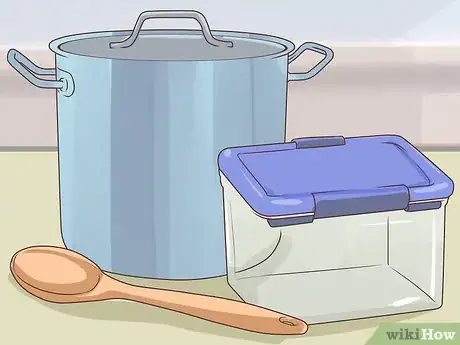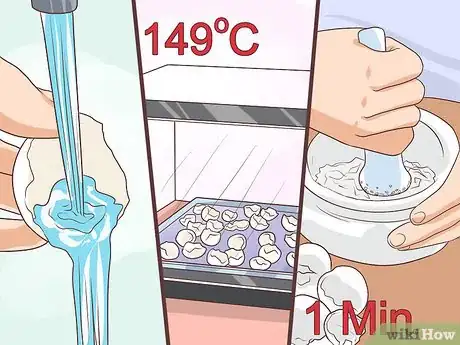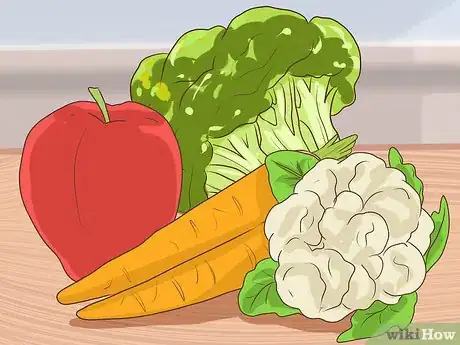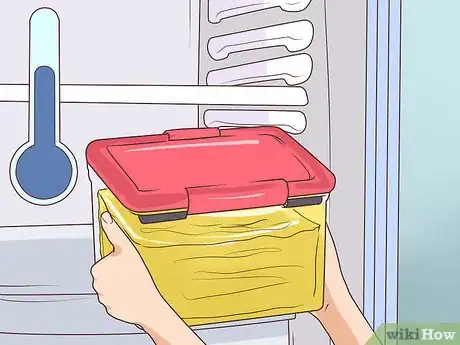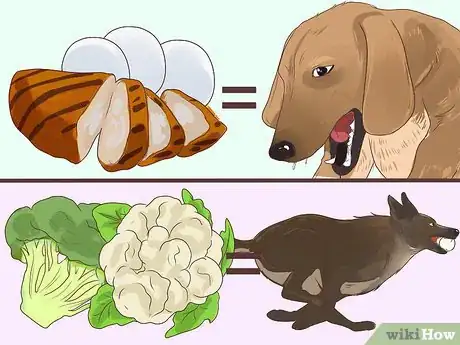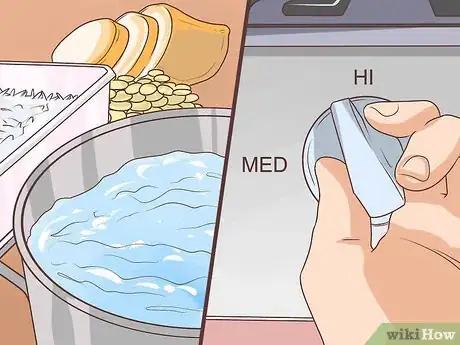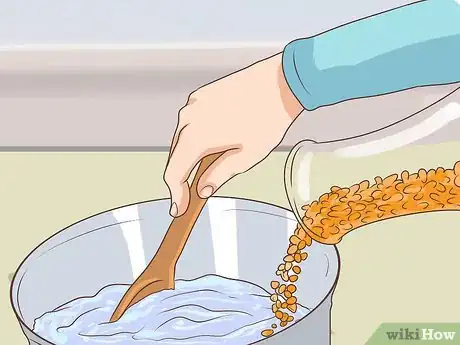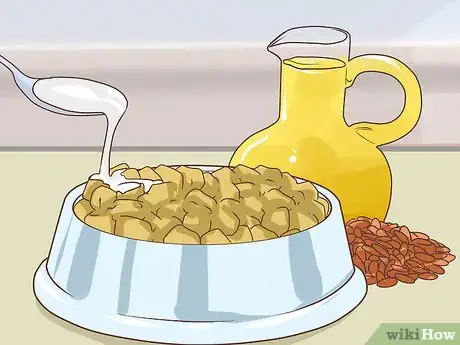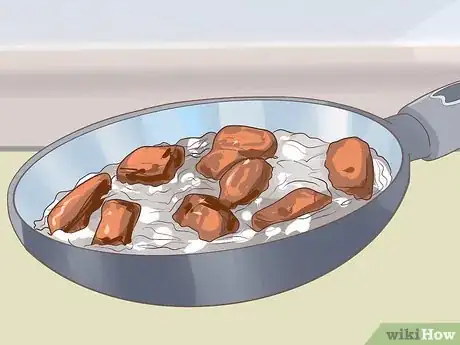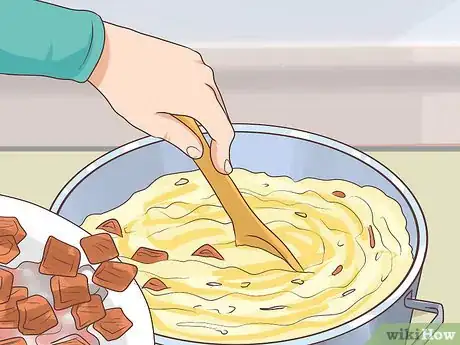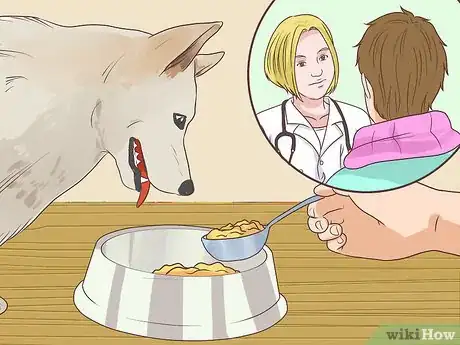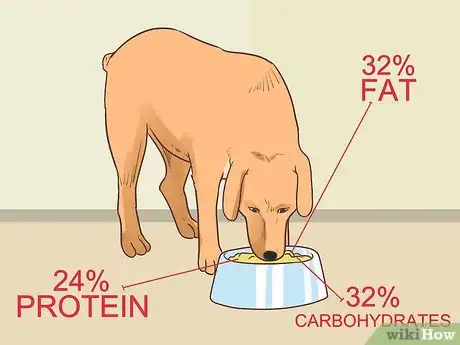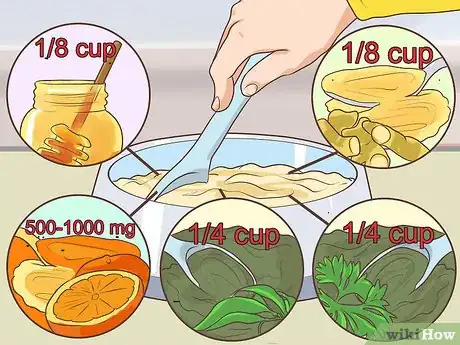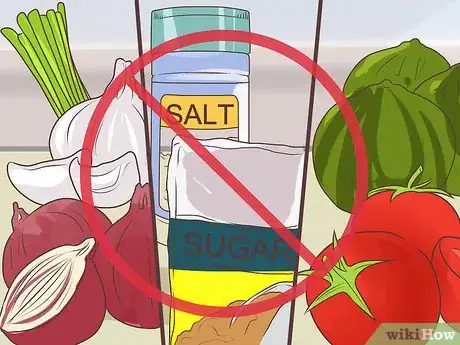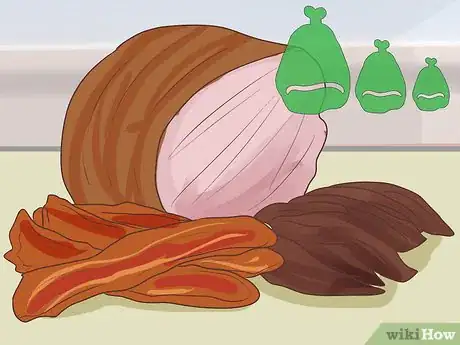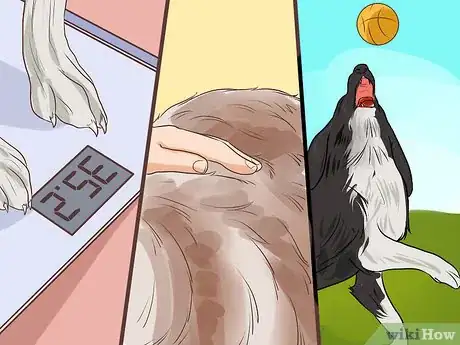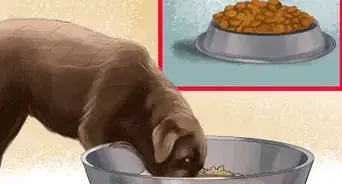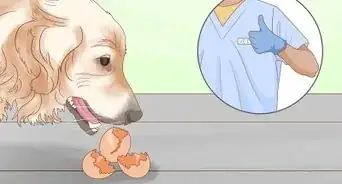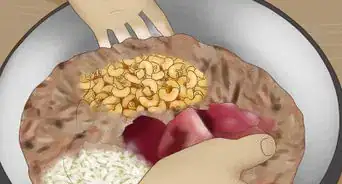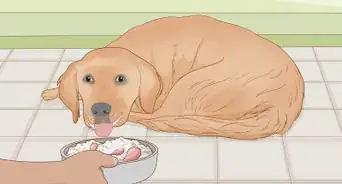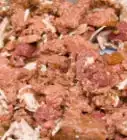This article was co-authored by Nicole Larocco-Skeehan. Nicole Larocco-Skeehan is a Dog Trainer and the Owner of Philly Unleashed in Philadelphia, Pennsylvania. Nicole has over 25 years of experience working with animals and currently specializes in group and private dog training and behavior modification. Nicole’s business has been named the "Best of Philadelphia" and she is the author of “The Teaching Dog: Partnering with Dogs for Instruction, Socialization, and Demonstration in Your Training Practice.” She was also on the Certification Council for Professional Dog Trainers Board of Directors. Nicole holds a Bachelor of Science in Marketing and Advertising from Robert Morris University.
There are 11 references cited in this article, which can be found at the bottom of the page.
This article has been viewed 55,764 times.
Feeding your pup homemade dog food gives you control over exactly what your dog eats, and allows you to customize food for picky eaters, sensitive stomachs, allergies, and medical issues. Making food at home also guarantees there are no fillers or unnecessary ingredients in Fido's bowl, and this will make for a happy and healthy pup. Homemade dog food might be easier to make than you think, and you'll probably be amazed by the variety of foods a dog can eat! However, there are also lots of foods that your canine companion cannot and should not eat, and it's also important to make sure that the food you make is balanced and provides all the nutrients your pet requires.
Ingredients
- 4 cups (740 grams) uncooked rice
- 9 cups (2.13 liters) water
- 1/4 cup (21 grams) oats
- 1/2 (118 ml) cup broth
- 2 tablespoons (5.3 grams) parsley, chopped fine
- 3 ounces (85 grams) liver, chopped fine
- 8 ounces (227 grams) ground beef (or chicken or lamb)
- 3 tablespoons (45 grams) corn oil
- 2 eggs, beaten
- 2 cups (300 grams) vegetables, finely chopped
- 1 ½ teaspoons (0.25 ounce) eggshell powder
- 6 cups (1.4 liters) water
- 1 cup (185 grams) mixed rice and quinoa
- 1 cup (200 grams) mixed lentils
- 3 medium sweet potatoes sliced into one-inch cubes
- 3 cups (24 ounces) natural peanut butter
- 8 grams (0.3 ounces) hemp protein
- 1 tablespoon (15 ml) flaxseed oil with DHA
- 1 serving cranberry extract
- 1 serving multivitamin powder
- 1 serving digestive enzyme
- 125 mg (1/4 pill) probiotic
- 2 cups (1 pound) ground or chunked turkey, chicken, or lean hamburger
- 5 cups (2.5 pounds) potatoes, diced into one-inch cubes
- 2 cups (180 grams) oats or wheat bran
- 1 teaspoon (5 ml) corn or walnut oil
- 1 ½ teaspoons (0.25 ounce) eggshell powder
Steps
Making Basic Dog Food
-
1Gather your supplies. For this recipe, you'll need your ingredients, a large stockpot, a large spoon, and an airtight storage container for leftovers.
-
2Make your eggshell powder. Calcium is an important part of a dog's diet, and one of the best sources is eggshells. Most dogs can't tolerate lactose, and it's not a good idea to feed them dairy products from a cow.
- Clean and dry out the shells from 12 eggs.
- Spread them on a baking sheet and bake in a 300 F (149 C) oven for five to seven minutes.
- Remove from the oven and allow to cool.
- Grind to a fine powder in a coffee grinder, about one minute.
- Store in an airtight container for up to two months.[1]
Advertisement -
3Get the rice and oats boiling. In a large stockpot, combine rice, water, and oats. Bring to a boil over medium-high heat.[2]
-
4Add the remaining ingredients. For the vegetable portion of the recipe, there are many vegetables that you can use or mix that will be good for your dog, including:
- Peas and carrots
- Broccoli and cauliflower
- Apples
- Beets
- Cabbage
- Spinach and other dark leafy greens
-
5Turn down the heat and continue cooking. Cook this for 20 to 25 minutes, until all the liquid has been absorbed and the vegetables are soft.
-
6Allow the food to cool. Don't put it away until it has reached room temperature. Once it has, transfer it to an airtight container and store in the refrigerator for up to a week.
- For longer-term storage, divide the mixture into individual portions and transfer each to a separate container. Store them in the freezer and thaw portions as needed.
Making Vegetarian Dog Food
-
1Learn why your dog may need a vegetarian/vegan diet. While dogs are naturally omnivorous, it is possible for them to develop sensitivities, allergies, and other stomach troubles. Frequent culprits for doggy food sensitivities include the proteins found in chicken and eggs, beef and dairy, wheat, and soy. In such cases, switching your dog to a vegan or vegetarian diet may be the solution.
- Allergy symptoms to look out for include itchy skin, hair and fur loss, ear infections, and frequent vomiting and diarrhea. Consult your veterinarian if your dog is exhibiting any of these signs.[3]
-
2Boil the water in a large stockpot on medium-high heat. When it comes to a boil, add the rice, lentils, and sweet potatoes. Lower the heat enough to reduce the pot to a simmer, and cook until everything is soft, about 40 minutes to an hour.
-
3Remove from heat. When the grains, legumes, and sweet potatoes have cooked until they're soft, take the pot off the heat. Use a fork or potato masher to partially mash the sweet potatoes. Allow the mixture to cool, approximately 30 minutes.
-
4Add the peanut butter. Give it all a good stir. When it has cooled fully to room temperature, transfer to airtight containers and store in the refrigerator, or in the freezer in individual portions.
-
5Add remaining ingredients before each meal. At feeding time, take a portion of food and stir in the hemp protein, flaxseed oil, cranberry extract, multivitamin, digestive enzyme, and probiotic.
- Use the recommended servings based on your dog's needs and weight.
- The cranberry extract will help balance the pH levels of your pooch's urine, and the digestive enzyme will help your dog absorb the highest possible amount of nutrients.[4]
Preparing Food for Overweight Dogs
-
1Boil the potatoes. Fill a large stockpot with cold water and place it on the stove. Add the potatoes, turn the heat to medium, and bring the potatoes to a boil. Continue cooking until soft, about 25 to 30 minutes.
- When the potatoes are soft, strain out the water and return the potatoes to the stockpot. Partially mash them with a fork or potato masher.
- To change the recipe up from time to time, swap out the potatoes and replace them with 3 ½ cups cooked rice.
-
2Add the oats. While the potatoes are still hot, add the oats or wheat bran and cover with a lid. Let stand for at least 10 minutes to help soften the oats.
- You can also substitute up to 2 cups of cooked vegetables for some or all of the oats.
-
3Cook the meat. Heat a large frying pan or skillet over medium heat. When it's hot, add the meat. Leave it alone for two minutes, and then spread it around with a spatula.[5]
- When there's no more pink on the one side, flip the meat over. When the pink has cooked out from that side as well, break the meat up into small pieces with the spatula.
- Continue cooking until there's no pink left anywhere on the meat.
- Some meat, like beef, will brown when it's cooked. Other meats, like chicken or pork, will go white when they're cooked.
-
4Add the meat to the potatoes and oats. Stir in the oil and eggshell powder as well. Stir to combine. Allow to cool to room temperature, and store leftovers in the fridge or freezer.
-
5Serve portions with balanced dog vitamins. Use the daily values recommended by the vitamin manufacturer based on the size of your dog.[6]
Feeding Your Dog Properly
-
1Provide the necessary vitamins and nutrients. Making your own dog food has many benefits, but it's important to make sure your dog gets everything he needs from his food. A proper diet will contain the right balance of protein, fat, carbohydrates, calcium, and essential fatty acids, all of which come from a variety of sources.[7]
- Protein comes from meat, eggs, seafood, beans, lentils, grains, and legumes.
- Fat comes from meat and healthy oils.
- Carbohydrates come from grains and vegetables.
- Calcium comes from eggshells.
- Essential fatty acids can be found in egg yolks, oats, and plant oils such as hemp and flaxseed.
-
2Feed your dog a balanced diet. Your dog's daily nutritional requirements will depend on several factors, including age, size, activity level, sex, and for females, whether or not she's pregnant or nursing. In general however, any dog's diet requires:[8]
- Between 16 and 24 percent protein.
- Between 10 and 32 percent fat.
- Between 44 and 32 percent carbohydrates (pregnant females and puppies need a higher percentage of protein and lower percentage of carbohydrates).
- Between 20 and 28 percent of their calories from protein.
-
3Make small changes to the recipes. Just like humans, dogs get different nutrients from different foods, so they need to eat a variety of foods. This doesn't mean feeding him a different recipe at every meal (which could upset his stomach), but make slight changes to the recipes you do make. Try adding new ingredients to each batch of food, such as:[9]
- 1/8 cup honey or tahini
- 500 to 1,000 mg of vitamin C powder
- 1/4 cup kelp powder
- 1/4 cup parsley or oregano
- 1/8 cup turmeric powder
-
4Avoid toxic foods. There's a long list of foods that dogs shouldn't have, and while some are acceptable from time to time, others are dangerous and should always be avoided. For a more complete list, check out the humane society's website. Toxic foods and foods to avoid include:
- Onions, garlic, and chives
- Salt and sugar
- Acidic foods like tomatoes and citrus fruits
- Most dairy products
- Chocolate
- Grapes and raisins
- Bread
- Coconut
- Avocado
- Apple seeds
-
5Allow some foods only in moderation. Some foods are acceptable in a canine diet in small quantities only. Cultured dairy products are one example: while many dogs cannot digest dairy products and lactose, cultured dairy products like yogurt don't contain a lot of lactose, and are safe in moderation.
- Bacon and ham are another example, as these foods are excessively fatty and should only be given to your dog in small amounts.[10]
- Liver should also only be given in moderation, as it contains high amounts of vitamin A, and can cause an overdose.[11]
- Table food from human meals is okay once in a while, as long as it is safe (e.g. bits of steak or sausage). Do not feed direct from the table though, give the dog this sort of food in their bowl or use it for training.
-
6Look for the signs of good health. A healthy diet means a healthy dog, and there are signs of good health that you can look for. If you suspect any issues, talk to your vet right away. Signs of good canine health include:[12]
- Proper weight
- Shiny coat
- Healthy skin
- Appropriate energy levels
- Firm, brown stool
Community Q&A
-
QuestionWhere do I find the calorie breakdown for the different recipes? I'm not sure how much to give my dogs.
 Community AnswerFor store-bought food, that information is located on the bags. Otherwise, you can use a calorie calculator meant for people. Enter the ingredients you used, then divide it by the number of servings you want. This will give you your calories per serving. If the calories are too high, divide it into more servings and recalculate.
Community AnswerFor store-bought food, that information is located on the bags. Otherwise, you can use a calorie calculator meant for people. Enter the ingredients you used, then divide it by the number of servings you want. This will give you your calories per serving. If the calories are too high, divide it into more servings and recalculate. -
QuestionCan I give bones to my dog?
 Community AnswerYes, you can but make sure it still has some meat on it and that they are not too small to prevent your dog from choking.
Community AnswerYes, you can but make sure it still has some meat on it and that they are not too small to prevent your dog from choking. -
QuestionWhich is better: white or brown rice?
 Community AnswerIt doesn't matter. White rice would probably be easier to use as it might be more palatable to your dog, but it's entirely up to you.
Community AnswerIt doesn't matter. White rice would probably be easier to use as it might be more palatable to your dog, but it's entirely up to you.
References
- ↑ http://moderndogmagazine.com/articles/diy-eat-eggshell-powder/28465
- ↑ http://www.gourmetsleuth.com/articles/detail/dog-food-recipes:
- ↑ http://pets.webmd.com/dogs/healthy-eating-for-dogs-14/slideshow-feeding-your-dog
- ↑ http://www.peta.org/living/companion-animals/say-kibble-vegan-dog-food-recipe/
- ↑ http://www.popsugar.com/food/How-Cook-Ground-Beef-29826801#photo-29826801
- ↑ http://www.organic-pet-digest.com/dog-weight-loss.html#Recipes
- ↑ http://damndelicious.net/2015/04/27/diy-homemade-dog-food/
- ↑ http://www.gourmetsleuth.com/articles/detail/dog-food-recipes
- ↑ http://thebark.com/content/recipes-dogs-barbara-lainos-homemade-dog-food
About This Article
To make homemade dog food, make sure to add finely ground eggshells, which provide the calcium your dog needs to be healthy. Additionally, put in some meat, like ground beef, chicken, or lamb, for protein. You should also include chopped vegetables, such as spinach, broccoli, and carrots, to provide vitamins and minerals. For a healthy dose of carbohydrates, try adding some rice, oats, or sweet potatoes. To learn how to make vegetarian dog food or food for your overweight dog, scroll down!
